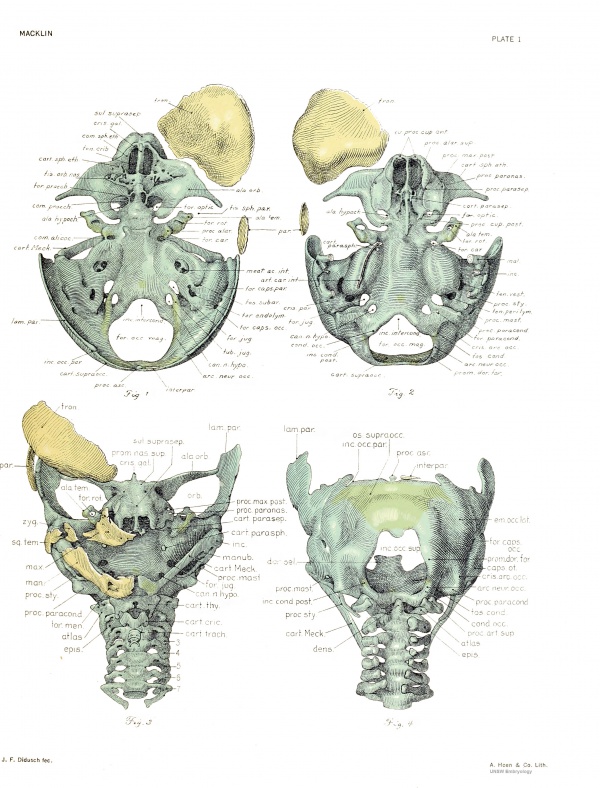Book - Contributions to Embryology Carnegie Institution No.48: Difference between revisions
(Created page with ":'''Links:''' Carnegie Institution of Washington - Contributions to Embryology -----Content to be added---- {{Template:Historic Discla...") |
No edit summary |
||
| Line 2: | Line 2: | ||
===Plate 1. The skull of a human fetus of 43 millimeters greatest length=== | |||
[[File:Macklin-plate01.jpg|600px]] | |||
All drawings were made by Mr. James F. Didusch according to geometric projection. With the exception of figure 7, which was made from a profile reconstruction, all figures were drawn from the original plaster-of-paris models made from human fetus No. 886 of the collection of the Carnegie Laboratory of Embiyology. The number of the model from which each figure was drawn is given, together with the magnification. | |||
Note - the magnifications refer to the original print versions, not the online images. | |||
'''Fig. 1. Chondrocranium from above with frontal and parietal bones on right side.''' The densest part of the frontal bone is inclosed by a dotted hne. The basal plate is not quite horizontal, the cranial end being a little the closer to the eye of the observer. Model 1. X6.25. | |||
'''Fig, 2. Chrondrocranium from below with cartilaginous branchial arch skeleton extirpated.''' Frontal and parietal bones are shown on right side. The basal plate is not quite horizontal, the caudal end being a httle the closer to the eye of the observer. The view is directly into the anterior nares. Model 1. X6.25. | |||
'''Fig. 3. Skull from front, showing membrane bones on right side.''' Face is seen in frank view. The cervical vertebrae and cartilaginous branchial arch skeleton are also seen. Model 1. X6.25. | |||
'''Fig. 4. Skull from back, giving a frank view of the foramen oocipitale magnum.''' The cervical vertebrtae are seen, their arches beiag as yet unclosed dorsaUy. Note the alignment of the hemiarch tips with the dorsal foraminal prominences, representing the extremities of the hemiarches of the occipital vertebra. The right half of the interparietal bone is seen. Model 1. X6.25. | |||
-----Content to be added---- | -----Content to be added---- | ||
Revision as of 10:20, 16 February 2011
Plate 1. The skull of a human fetus of 43 millimeters greatest length
All drawings were made by Mr. James F. Didusch according to geometric projection. With the exception of figure 7, which was made from a profile reconstruction, all figures were drawn from the original plaster-of-paris models made from human fetus No. 886 of the collection of the Carnegie Laboratory of Embiyology. The number of the model from which each figure was drawn is given, together with the magnification.
Note - the magnifications refer to the original print versions, not the online images.
Fig. 1. Chondrocranium from above with frontal and parietal bones on right side. The densest part of the frontal bone is inclosed by a dotted hne. The basal plate is not quite horizontal, the cranial end being a little the closer to the eye of the observer. Model 1. X6.25.
Fig, 2. Chrondrocranium from below with cartilaginous branchial arch skeleton extirpated. Frontal and parietal bones are shown on right side. The basal plate is not quite horizontal, the caudal end being a httle the closer to the eye of the observer. The view is directly into the anterior nares. Model 1. X6.25.
Fig. 3. Skull from front, showing membrane bones on right side. Face is seen in frank view. The cervical vertebrae and cartilaginous branchial arch skeleton are also seen. Model 1. X6.25.
Fig. 4. Skull from back, giving a frank view of the foramen oocipitale magnum. The cervical vertebrtae are seen, their arches beiag as yet unclosed dorsaUy. Note the alignment of the hemiarch tips with the dorsal foraminal prominences, representing the extremities of the hemiarches of the occipital vertebra. The right half of the interparietal bone is seen. Model 1. X6.25.
Content to be added----
| Historic Disclaimer - information about historic embryology pages |
|---|
| Pages where the terms "Historic" (textbooks, papers, people, recommendations) appear on this site, and sections within pages where this disclaimer appears, indicate that the content and scientific understanding are specific to the time of publication. This means that while some scientific descriptions are still accurate, the terminology and interpretation of the developmental mechanisms reflect the understanding at the time of original publication and those of the preceding periods, these terms, interpretations and recommendations may not reflect our current scientific understanding. (More? Embryology History | Historic Embryology Papers) |
Glossary Links
- Glossary: A | B | C | D | E | F | G | H | I | J | K | L | M | N | O | P | Q | R | S | T | U | V | W | X | Y | Z | Numbers | Symbols | Term Link
Cite this page: Hill, M.A. (2024, April 19) Embryology Book - Contributions to Embryology Carnegie Institution No.48. Retrieved from https://embryology.med.unsw.edu.au/embryology/index.php/Book_-_Contributions_to_Embryology_Carnegie_Institution_No.48
- © Dr Mark Hill 2024, UNSW Embryology ISBN: 978 0 7334 2609 4 - UNSW CRICOS Provider Code No. 00098G

